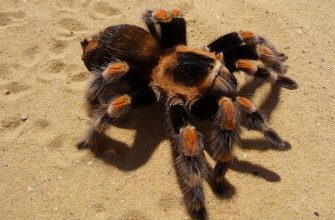Having an unique appearance, exceptional colors and interesting behavior, crayfish enliven an aquarium. They attract novice aquarists because they are easy to care for; experienced aquarists get crayfish for species diversity and maintaining cleanliness in the aquarium.
General information about aquarium crayfish
Crayfish of the Cambaridae and Parastacid families are more common in aquariums. The first ones inhabit water bodies of the Northern Hemisphere, the second ones live in the Southern Hemisphere. Among the “southern” crayfish, representatives of the Cherax genus are especially popular in aquaculture because of their surprisingly bright colors.
In nature crayfish prefer fresh slow-flowing rivers, streams, lakes, and ponds. They don’t survive in dirty water.
The body of aquarium crayfish is covered with a chitinous shell and consists of cephalothorax, a flat mobile pleon and tail. The cephalothorax has five pairs of legs, the first of which is armed with large pincers and the other four are walking legs. There are 10 limbs in total. Hence, the name of the order to which they belong is Decapods, or ten-legged crustaceanss.
Crayfish show clear sexual dimorphism. Males are bigger and with powerful pincers. Female’s pincers are shorter and wide. Females also have a wide pleon (abdomen) to keep their eggs safe when they are underneath them. A male’s pleon is elongated. The exception is a Marble Crayfish. All individuals of this species look the same because all of them are females.
Crayfish lead a solitary lifestyle. During the day they hide in burrows, covering the entrance with pincers. At night or in the afternoon, if crayfish are not disturbed by bright lighting, they eat. Building shelters, crayfish move aquarium decorations and carry pebbles over long distances. Fights for females and territory occasionally occur. In cases of danger a tail fin is used to make the water murky; while the water is clearing, the crayfish has time to hide.
The most striking and popular aquarium species of crayfish
There are a wide variety of crayfish; the most striking and the ones most adapted for keeping in aquariums are:
– Marble Crayfish (Procambarus virginalis)
This species was discovered in Germany relatively recently – in the middle of 1990s. Individuals can be any colour – brown, green or black; only the marble pattern does not change. The size is 13-15 cm. There are no male marble crayfish; reproduction relies on females cloning.
– Blue Florida Crayfish (Procambarus alleni)
This species has been developed through breeding at a crayfish farm in Florida, in the USA. In spite of their rather small size (up to 10 cm), two of them require an aquarium with a capacity of 100 litres of water. A special feature of this species is the lilac iridescence on a bright blue shell.
– Blue Cuban Crayfish (Procambarus cubensis)
This is the ornamental species which was the very first to be introduced into aquariums. Originally, as the name suggests, they came from Cuba. The average size is 12 cm. It prefers warm water: +22…+27°C. The translucent colorless body becomes one of different shades of blue by the age of 1,5 years.
– Red Swamp Crayfish (Procambarus clarkii)
The typical representative of North America swamps. These crayfish are 10-12 cm long. Red-brown is their usual color, but depending on the composition of water, the color can vary from bluish to dark brown. The species quickly adapts to new conditions, tolerating temperature changes in the range of +5…+35 °C.
– Mexican Dwarf Orange Crayfish (Cambarellus patzcuarensis)
When fully grown, it is just 5 cm long. The body of these miniature arthropods is covered with bright orange or red chitin, which is the result of hard work of breeders. Crayfish of this species have lived up to 2 years in captivity. Unlike large crayfish, this one does not eat aquarium plants.
– Australian Cyan Yabby Crayfish (Cherax Destructor Yabby)
The species is native to Australia where it inhabits the wetlands.
Its ultramarine chitinous cover looks very impressive. Other characteristics are impressive too: the size of fully grown crayfish is 20 cm long and their lifespan is up to 10 years. It is believed that they are endowed with intelligence. They distinguish and interact with other members of their species and are able to remember places they have visited before.
– Zebra Crayfish (Cherax papuanus)
This species is found in New Guinea. They grow to a maximum of 15 cm long and are brown in color, with a zebra pattern on their tail. Observation shows that this species is slightly difficult due to its furtive, nocturnal lifestyle. Zebra crayfish are friendly to other aquarium inhabitants, but dig up the substrate, not allowing aquarium plants to be become rooted in.
Care and maintenance
When choosing an aquarium, the species of crayfish and the size of the adult individual should be taken into account. The recommended minimum volume of the aquarium is 20 liters per arthropod larger than 5 cm. The aquarium should be equipped with a glass cover to prevent crayfish from escaping.
The main parameters of water, which are suitable for keeping aquarium crayfish, are shown in the table:
-
Temperature
19-25°C
Acidification level
6,5–7,5 pH
Hardness
8–12 dGH
Oxygen concentration
5 mg per liter
Soft and acidic water is not suitable, due to the lack of calcium, which is needed to form and maintain the rigid shell of crayfish.
It is recommended that the bottom of the aquarium be covered with a 6-cm layer of fine quartz gravel (with pieces of 2-3mm in size) as substrate. Stones, driftwood, grottos and other decorations should not have sharp edges, to avoid crayfish being injured after their molting. Crayfish like to hide in coconut shell halves, ceramic pipes and pots. The more aquarium bottom decorations, the less crayfish clashes for territory there will be. However, placing of ready-to-use shelters on the aquarium bottom does not turn off their genetically engineered need to dig holes.
It would be ideal, if the aquarium is equipped with a powerful compressor and a filter with a flow reducing device. Lack of oxygen and filtration leads crayfish to escape through the tubes of the equipment. But, even with the powerful filtration, it should not forget to renew the water. In volumetric tanks 50% of the water is replaced every 7 days; in small tanks 20% to 30% of the water is replaced 2 times a week.
Crayfish are nocturnal, spending most of the day hiding in burrows. So lighting is of secondary importance for them.
Crayfish are omnivores. They like eating pieces of meat, offal, fish, and seafood. To prevent crayfish from eating aquarium plants, it’s recommended to enrich their diet with carrots, cucumbers, lettuce leaves, and also to provide a balanced food for bottom-feeding fish.
Peace-loving creatures?
There is a constant debate about whether it is possible or not to keep crayfish together with other aquarium inhabitants. Their coexistence is possible but it is fraught with risk. It is safer for the crayfish themselves to be settled in a species aquarium. The crayfish will definitely hunt for small slow-moving fish and shrimps at night. But they will be afraid of such as the cichlids, hiding in the hole and fearing to go out for food. This is particularly evident during the molting period.
Young crayfish molt every week. This is the only way to grow and to restore lost limbs. Adult ones change their chitinous cover 2-3 times a year. The crayfish body remains soft and vulnerable to predators until it is getting hardened. If there is no chance to keep crayfish separately, then better to have active, medium sized fish as their neighbors. Danio, mollinesia and barbus are species that get along quite well with crayfish.
Fish breeds with veiled fins and catfish which live in the bottom layer of an aquarium make unsuitable neighbors.
Aquarium caretakers
At night crayfish actively explore the bottom, searching for food. Having immunity to putrefactive bacteria and many pathogens, they eat the remains of food, dead parts of aquatic plants and fish. Thus, they clean the bottom of the aquarium removing biological residues and preventing the spread of rotting products and the infection of other aquarium inhabitants with bacteria, viruses or parasites. That’s why they rightly could be called aquarium caretakers.







